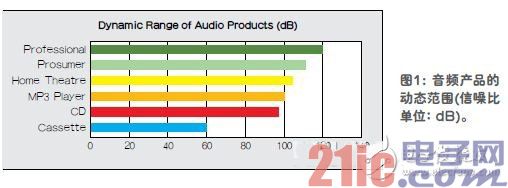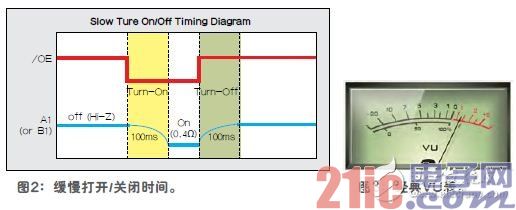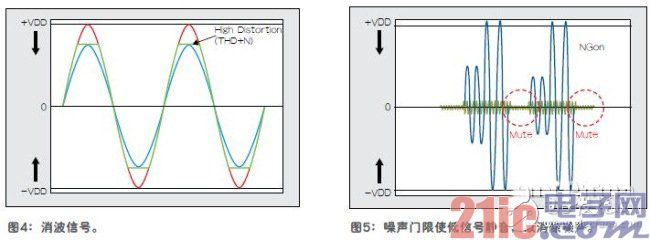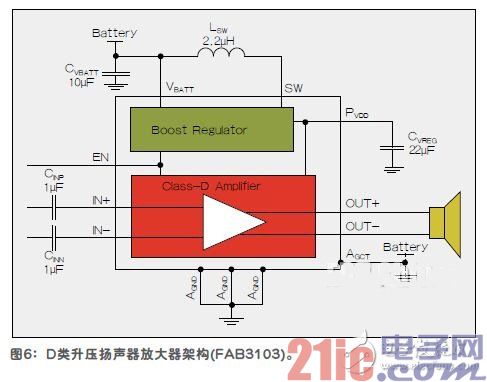There are two important cross-cutting factors driving the development of audio for mobile phones and tablets: 1. Increasing product differentiation requirements; 2. Higher customer expectations. Smartphone and tablet OEMs are building platforms around chipsets using various combinations of application processors and baseband modems (integration and combination) from various commercial IC vendors. As a result, OEMs do not control or differentiate functional groups as they do when specifying and/or designing chipsets. Today, they must look for other ways to create differentiated mobile user experiences, including providing an audio experience anytime, anywhere. In order to achieve this goal, it is necessary to make full use of the speakers of mobile phones and tablets, and it is known that their volume is small. Therefore, you need to add DSP sound processing (aka: audio post-processing) to eliminate clicks and use other audio techniques to create low power consumption without unwanted secondary effects (such as electromagnetic interference). Output (high volume) speaker amplifiers; also need to identify some important parameters, techniques, trends, and innovations that engineers use to provide better sound.
This article refers to the address: http://
When mobile phone companies use commercial chipsets, they need to find new ways to achieve a variety of product appearance, feel, sound, and what features users can experience. For sound, mobile phone users have very low audio performance requirements not long ago, so it is good to put any amplifier into the core chipset. However, with the emergence of more and more innovative phones, tablets and applications on the market, user expectations are also rapidly increasing, including audio. Users want to enjoy good sound quality anytime, anywhere.
By adding DSP sound processing (aka: Audio Post Processing), you can eliminate clicks and use other audio techniques to create high-output (high volume) speaker amplifiers.
Audio engineering is an artistic job, because sound is a subjective personal experience, and audio engineering requires constant trade-offs and judgments. The following examples show several techniques that audio engineers use to introduce better sound to mobile platforms. Each one is worth exploring in depth, but we'll just give a brief introduction to review a few important issues, trends, and solutions.
1. Dynamic range, signal-to-noise ratio (SNR) and total harmonic distortion plus noise (THD+N)
The classic measure of audio performance is the signal-to-noise ratio or dynamic range. As with many other comparable measures of product performance, the signal-to-noise ratio is constrained by the “technical indicator gapâ€, and the different interpretations of the “technical indicator gap†are used to best position the product, not completely considering objective purity. To provide better objectivity, the Society of Audio Engineers (AES) created standards for audio engineering measurement. Total harmonic distortion plus noise is a more common and useful measure than total harmonic distortion alone, because it can more accurately reproduce use cases (ie, noisy matter). Bring it into the formula: Total Harmonic Distortion + Noise = Harmonic Power + Noise Power Total divided by total output power. Note that the output power only makes sense when the level of distortion at the time of measurement is constant.
Figure 1 compares the dynamic range of different audio devices, from CDs to professional audio. The driving force behind the audio performance of mobile phones and tablets is to catch up with the dynamic range of MP3 players (about 100 dB), which is now being achieved in the mobile and tablet markets.

2. Microphone and audio post processing
It is necessary to support several microphones on the mobile platform, as DSP echo cancellation and other advanced audio and speech processing require multiple microphones. Differential microphone inputs are used to reduce the occurrence of noise, radio frequency and crosstalk. In mobile audio systems, microphones, audio codecs, and DSP processors work together to implement advanced features. The enhancement of intelligent machine audio is being concentrated on the battlefield of DSP. DSP echo cancellation, 3D space and other audio functions use multiple microphones to provide input for processing. A simple example is the need for at least two microphones to separate the speech signal from the background noise. One microphone listens to speech and background noise, and the other only listens to background noise. The DSP/codec system then receives those signals and subtracts the noise to provide a clearer speech signal.
The use of digital microphones (electret condenser microphones and MEMS microphones) instead of analog microphones is gaining popularity, driven by mobile OEMs, as their digital footprints inflict noise on cell phone processors and broadcast integrated circuits such as baseband modems. Has better immunity.
3. Reduce the buzz
Noise is a classic problem in audio. It often happens when the audio input is turned on, off, muted, or connected to different loads. It can cause transients and can be heard through the speakers or headphones. Reducing clicks is becoming more important in mobile applications, as moving operations naturally cause objects to shut down to save power. Of course, this means that it should be turned on again to create an on/off and off/on transition, resulting in a sound transient. In the past, reducing hum was solved by external capacitors. However, as the level of integration increases, in order to reduce expenses and improve performance, it is necessary to reduce the capacitance and provide an innovative chip method to reduce the hum.
The transition between the internal and external microphones is another source of clicks when plugged into the phone. This can be managed by providing an insertion detection circuit. Slow opening and closing is another way to suppress snoring. Slowly turning it on and off is very useful for audio drivers that do not have a DC blocking capacitor because it produces a DC offset voltage. Slowly open, as its literal meaning, ramping the switching resistor, so that the load voltage slew rate is slowly increased, so that the click sound does not appear. One way is to use an integrated audio switch that is slowly turned on. The Feizhao slow-on audio switch of Figure 2 demonstrates this concept. This product has adjustable (slow) on and off, ranging from 1 millisecond to 200 milliseconds. This figure shows the setting for 100 milliseconds.
Especially for mobile devices, hum design becomes very critical, which is another reason why audio engineering looks like art, because the perception of hum is very subjective, making experience and some small skills a success. important part.
4. Dynamic range control (DRC) and speaker protection
Those who turn the home stereo amplifier sound (not) will notice the situation when the speaker is overdriven. Your ears will have to endure the harsh distortion. On the other hand, if the amplifier is not close to the maximum speaker size, the speaker will not produce a loud sound. Need to approach a microwire. One approach is to control the gain of the amplifier through dynamic range control, trying to optimize the sound quality to prevent distortion when the recorded signal level is maximized. This is like when you used to perform analog recordings, you can manually adjust the input volume while observing the recorder VU meter (Figure 3) so that the pointer is always outside the red area when the path is loud, and the volume is raised during quiet periods to mask the simulation. The deviation sound of the recorder.

This literally means manual dynamic range compression. Today, this can be done automatically by integrated circuits, monitoring signal levels and providing feedback to increase or decrease gain. The result is a suppression of the sound range (ie, high and low levels and low and high levels), which makes the listener hear better. However, as the volume of the small speaker increases, the risk of damage increases. Therefore, speaker protection methods are becoming increasingly important.
One of the most dangerous phenomena that can occur with a speaker is the phenomenon of clipping. When the amplifier is driven beyond the speaker limit, clipping occurs, which makes the signal look more and more like a square wave, rather than a normal audio signal. The term "wavelet" is used because the upper part appears to be flattened (Figure 4).
The reason why the wave is dangerous to the speaker is that when the signal starts to be flattened, more high harmonics are generated, which exceeds the energy that the speaker can withstand and causes permanent damage. Mobile audio amplifiers now add an anti-crash mechanism to limit their output and better match the speakers. The most basic anti-cancellation method is to set the gain so that it is not higher than the level preset by the automatic gain control (AGC) technique. Other more sophisticated speaker protection methods are being developed to actively monitor the speaker status and feed back information to the amplifier to ensure safe operation. Some active speaker protection schemes can utilize the small signal processor of the amplifier itself for signal analysis. All types of speaker protection, whether active or passive, make it easier for mobile platform manufacturers to deliver louder, more durable audio, so speaker protection will continue to be a key issue in the audio kingdom. 5. Noise threshold
Some mobile audio amplifiers currently offer a noise threshold. When the signal is below a specified level, the noise threshold silences the output, like the old squelch suppression circuitry, which reduces broadcast, DAC, and other noise in the system (Figure 5). The noise threshold feature is more useful for speech than music. Depending on the design, the intervention and attenuation parameters are sometimes used to control and set the noise threshold.

6. Equalization
The equalizer is just a set of faders that are used for narrow ranges of frequencies over the entire audio range. The five-band equalizer is especially suitable for mobile platforms. The equalizer allows the system designer to customize the output signal to optimize speaker performance in a specific environment. In the early days of high-fidelity stereo, the average audio consumer began to know the equalizer. It has been pointed out that once the equalizer is set up, the special sound in the room is “one-offâ€. This is a similar case; but mobile designers are more concerned about phones and tablets than rooms. The idea is to match the speaker to the best acoustic performance box. Equalization is important if you plug the speakers into a non-optimal position in the box (as often due to industrial design considerations). An equalizer on the chipset internal codec or external audio codec sets parameters for a particular enclosure (box) to improve the overall sound quality of the product. Equalization can be seen as an important DSP function that makes the phone sound better.
7. Class D amplifier and reduce electromagnetic interference
In the end, the audio discussion seems to have to revolve around the idea of ​​category competition—meaning it is a comparison of different categories of audio amplifiers. Let's take a look. Class D is an excellent technology for mobile devices, because its efficiency is much better than that of Class AB, but the disadvantage of Class D is electromagnetic interference, and its sound quality is not as good as Class AB. The invisible hand of the market has weighed the pros and cons, and it seems that Class D is more acceptable for speaker amplifiers, at least for now. For headphones, Class AB, Class G, and Class H are still common choices, although Class D is sometimes used.
The trend in Class D is to eliminate unnecessary electromagnetic interference generated by its built-in pulse width-width modulation conversion architecture, which requires different methods to suppress electromagnetic interference. One suppression method applied to a pulse width-width modulated system (such as Class D) is spread spectrum modulation, in which the output bridge switching frequency varies around the center switching frequency. As the frequency changes randomly, the electromagnetic energy is more widely distributed and the peak radiant energy is reduced.
Another way to reduce electromagnetic interference is edge rate control (ERC). In Class D products, the high frequency energy is at the edge of the pulse width modulated square wave output, so a faster number of output rises and falls will produce higher frequency energy. By reducing the sharpness of the edges, the high frequency energy is reduced. Recall that the more perfect a square wave (ie, the more it is), the more harmonics will be generated. Therefore, reducing the square wave's perfection can reduce the high-frequency harmonic components that generate radiation. However, this in turn consumes more power. At the same time, at the moment, we should be clear that changing the shape of the square wave is actually destroying it, thereby increasing the total harmonic distortion plus noise, although this is deliberate. Therefore, when deciding what is acceptable, a trade-off is needed. Once again, we can see that making the right trade-offs is really part of a good audio engineering art.
8. Enhanced Speaker Amplifier
An important trend in mobile audio is the conversion of louder audio, which is achieved by high output speaker amplifiers. The high output is suitably added to the speaker amplifier IC by a DC-DC boost converter. A good example of a Class D built-in boost amplifier is the Fairchild FAB3103 (Figure 6).

The addition of a DC/DC boost converter has a very important impact on the audio IC partitioning, which is not suitable for integration into analog mobile baseband or audio coding ICs due to the voltage level of the boost circuit. Therefore, the need for louder voices has opened the trend to separate audio amplifiers from codec systems and analog baseband devices.
The current output power of speaker amplifiers is between 1.7W and 2.5W, which is still growing, as mobile platform manufacturers say they want to output as much sound as possible. Higher output drivers, of course, mean more power consumption, which is not what mobile platform manufacturers want. Therefore, audio engineers are looking for new ways to re-use old methods to reduce power. One of the innovative methods currently available for Class D is to borrow the concept of Class G, which uses a power multiplexer. The Fairchild FAB3103 is a Class D audio amplifier that uses this technology.
9. New directions
A new area of ​​advancement in mobile audio is to pay attention to flat-panel speaker or even the appearance of a mobile phone or tablet as a speaker. Another point of view is to divert the high-definition music flowing out of the cloud. Industry researchers say the mobile music diversion will increase the number of registrants from 6 million in 2011 to 160 million in 2016, with a combined annual growth rate of 95%. With the rapid growth of audio streaming, mobile and tablet hardware products will need to be equipped with audio ICs for a mobile audio experience anytime, anywhere.
18650 Battery,18650 Li Ion Battery Pack,10000Mah 18650 Battery Pack,18650 Lithium Battery Pack
Shenzhen Glida Electronics Co., Ltd. , https://www.szglida.com
